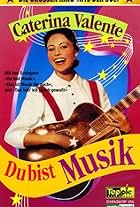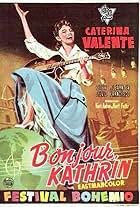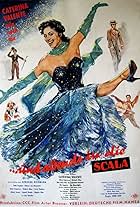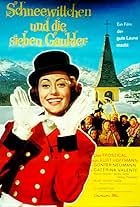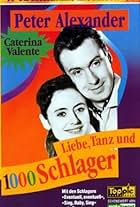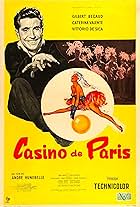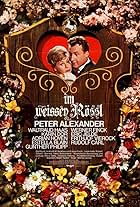Bill Haley
- Self
- (as Bill Haley and the Comets)
Franny Beecher
- Comets musician
- (uncredited)
Johnny Grande
- Comets musician
- (uncredited)
Ralph Jones
- Comets musician
- (uncredited)
Günter Meisner
- Regieassistent
- (uncredited)
Joe Olivier
- Comets musician
- (uncredited)
Al Pompilli
- Comets musician
- (uncredited)
Rudy Pompilli
- Self - Saxophonist, The Comets
- (uncredited)
Billy Williamson
- Comets musician
- (uncredited)
Storyline
Did you know
- TriviaBill Haley and the Comets were last-minute additions to the cast. They were touring Germany at the time, and had made headlines the night before shooting when one of their Berlin shows turned into a riot. The next morning, as the band prepared for their shoot, Catarina Valente as a joke came on set wearing riot gear, asking directions to the Haley concert.
- SoundtracksEs singen und tanzen
Caterina Valente
Bill Haley
Gerard Nel
Raskos & Jourdan
Die Moonlights
Das Comedien-Quartett
Featured review
Enchanting hit comedy with the great Caterina Valente
This German hit film, made in 1959, was based on the French play "J'y suis, j'y reste" by Raymond Vincy and Jean Valmy, which premiered in 1950. The director was Werner Jacobs, who had already made the film "Das einfache Mädchen" (1957) with Caterina Valente and was supposed to make "Im Weissen Rössl" (1960) with Peter Alexander. The film was produced by Artur Brauner's CCC-Film under the production management of Horst Wendlandt, who would go into business for himself a few years later with the Karl May films. The script was written by Curth Flatow, who would become very well known in the 1980s with the popular television series "Ich heirate eine Familie". Filming took place near Bamberg, at Seehof Castle and in the Berlin CCC studios.
When the Parisian restaurant owner Catherine (Caterina Valente) wants to marry her long-time fiancé (Wolfgang Müller), she finds out at the registry office that she has long been married to Baron Hubert von Löwenherz (Hans Holt). Indignant, she drives to his castle to demand a divorce. This leads to funny, if easily predictable, mix-ups and misunderstandings that determine the further course of the always entertaining plot.
The actors in this film are really great, especially the fantastic Caterina Valente, who dances and sings everything and everyone to the ground. Her dance performances, whether alone (she dances the entire opening credits of the film) or with partners, are particularly beautiful. In addition to the five hits she sang (e.g. "A little Pompadour" and "Let's see a captain"), at the end she sings "Vive la Rock and Roll" with guest star Bill Haley and thus creates a connection with them the music popular with the youth of the time. But the other actors are also great: Hans Holt (known from "The Trapp Family"), Margarete Haagen ("The Girls from Immenhof"), Paul Henckels (Professor Bömmel from "Die Feuerzangenbowle"), Boy Gobert as a scheming butler and the charming Ann Smyrner as blonde Poison. Three supporting actors deserve special recognition. Ruth Stephan (1925-1975), also known from films with Heinz Erhardt, shines with an outstanding performance as the maid Lucie, who develops from a wallflower to a proud swan. Also taking part are the two cabaret artists Wolfgang Müller and Wolfgang Neuss, who already knew how to impress alongside Liselotte Pulver in "Das Wirtshaus im Spessart" (1957). Wolfgang Neuss is allowed to play a television presenter here and, with joy and enthusiasm, throw out biting remarks against the competing medium of television, which only a few years later was one of the triggers for the decline of the German film industry.
In addition to the beautiful singing performances with Caterina Valente, there are also wonderfully chaotic scenes in the Paris restaurant, where the entire inventory is destroyed with concentrated playfulness and slapstick fights. It's wonderful that a German film can be so funny and charming! It's just a shame that the film wasn't shot in CinemaScope. What was already common in the Italian film industry at the time only really became established in German cinema with the Karl May films.
This film is definitely worth discovering and Caterina Valente certainly doesn't need to shy away from comparison with other musical stars of the time.
Definitely worth seeing!
This German hit film, made in 1959, was based on the French play "J'y suis, j'y reste" by Raymond Vincy and Jean Valmy, which premiered in 1950. The director was Werner Jacobs, who had already made the film "Das einfache Mädchen" (1957) with Caterina Valente and was supposed to make "Im Weissen Rössl" (1960) with Peter Alexander. The film was produced by Artur Brauner's CCC-Film under the production management of Horst Wendlandt, who would go into business for himself a few years later with the Karl May films. The script was written by Curth Flatow, who would become very well known in the 1980s with the popular television series "Ich heirate eine Familie". Filming took place near Bamberg, at Seehof Castle and in the Berlin CCC studios.
When the Parisian restaurant owner Catherine (Caterina Valente) wants to marry her long-time fiancé (Wolfgang Müller), she finds out at the registry office that she has long been married to Baron Hubert von Löwenherz (Hans Holt). Indignant, she drives to his castle to demand a divorce. This leads to funny, if easily predictable, mix-ups and misunderstandings that determine the further course of the always entertaining plot.
The actors in this film are really great, especially the fantastic Caterina Valente, who dances and sings everything and everyone to the ground. Her dance performances, whether alone (she dances the entire opening credits of the film) or with partners, are particularly beautiful. In addition to the five hits she sang (e.g. "A little Pompadour" and "Let's see a captain"), at the end she sings "Vive la Rock and Roll" with guest star Bill Haley and thus creates a connection with them the music popular with the youth of the time. But the other actors are also great: Hans Holt (known from "The Trapp Family"), Margarete Haagen ("The Girls from Immenhof"), Paul Henckels (Professor Bömmel from "Die Feuerzangenbowle"), Boy Gobert as a scheming butler and the charming Ann Smyrner as blonde Poison. Three supporting actors deserve special recognition. Ruth Stephan (1925-1975), also known from films with Heinz Erhardt, shines with an outstanding performance as the maid Lucie, who develops from a wallflower to a proud swan. Also taking part are the two cabaret artists Wolfgang Müller and Wolfgang Neuss, who already knew how to impress alongside Liselotte Pulver in "Das Wirtshaus im Spessart" (1957). Wolfgang Neuss is allowed to play a television presenter here and, with joy and enthusiasm, throw out biting remarks against the competing medium of television, which only a few years later was one of the triggers for the decline of the German film industry.
In addition to the beautiful singing performances with Caterina Valente, there are also wonderfully chaotic scenes in the Paris restaurant, where the entire inventory is destroyed with concentrated playfulness and slapstick fights. It's wonderful that a German film can be so funny and charming! It's just a shame that the film wasn't shot in CinemaScope. What was already common in the Italian film industry at the time only really became established in German cinema with the Karl May films.
This film is definitely worth discovering and Caterina Valente certainly doesn't need to shy away from comparison with other musical stars of the time.
Definitely worth seeing!
- ZeddaZogenau
- Oct 18, 2023
- Permalink
Details
- Release date
- Country of origin
- Language
- Also known as
- Tu sam i tu ostajem
- Production company
- See more company credits at IMDbPro
Contribute to this page
Suggest an edit or add missing content

















